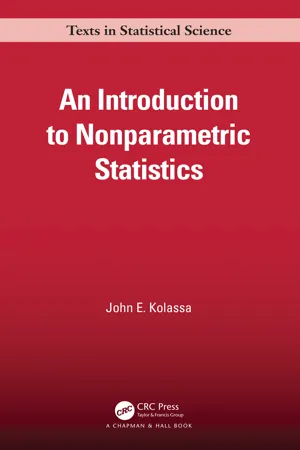
- 224 pages
- English
- ePUB (mobile friendly)
- Available on iOS & Android
An Introduction to Nonparametric Statistics
About this book
An Introduction to Nonparametric Statistics presents techniques for statistical analysis in the absence of strong assumptions about the distributions generating the data. Rank-based and resampling techniques are heavily represented, but robust techniques are considered as well. These techniques include one-sample testing and estimation, multi-sample testing and estimation, and regression.
Attention is paid to the intellectual development of the field, with a thorough review of bibliographical references. Computational tools, in R and SAS, are developed and illustrated via examples. Exercises designed to reinforce examples are included.
Features
-
- Rank-based techniques including sign, Kruskal-Wallis, Friedman, Mann-Whitney and Wilcoxon tests are presented
-
- Tests are inverted to produce estimates and confidence intervals
-
- Multivariate tests are explored
-
- Techniques reflecting the dependence of a response variable on explanatory variables are presented
-
- Density estimation is explored
-
- The bootstrap and jackknife are discussed
This text is intended for a graduate student in applied statistics. The course is best taken after an introductory course in statistical methodology, elementary probability, and regression. Mathematical prerequisites include calculus through multivariate differentiation and integration, and, ideally, a course in matrix algebra.
Frequently asked questions
- Essential is ideal for learners and professionals who enjoy exploring a wide range of subjects. Access the Essential Library with 800,000+ trusted titles and best-sellers across business, personal growth, and the humanities. Includes unlimited reading time and Standard Read Aloud voice.
- Complete: Perfect for advanced learners and researchers needing full, unrestricted access. Unlock 1.4M+ books across hundreds of subjects, including academic and specialized titles. The Complete Plan also includes advanced features like Premium Read Aloud and Research Assistant.
Please note we cannot support devices running on iOS 13 and Android 7 or earlier. Learn more about using the app.
Information

Table of contents
- Cover
- Half Title
- Series Page
- Title Page
- Copyright Page
- Contents
- Introduction
- 1. Background
- 2. One-Sample Nonparametric Inference
- 3. Two-Sample Testing
- 4. Methods for Three or More Groups
- 5. Group Differences with Blocking
- 6. Bivariate Methods
- 7. Multivariate Analysis
- 8. Density Estimation
- 9. Regression Function Estimates
- 10. Resampling Techniques
- Appendix A: Analysis Using the SAS System
- Appendix B: Construction of Heuristic Tables and Figures Using R
- Bibliography
- Index